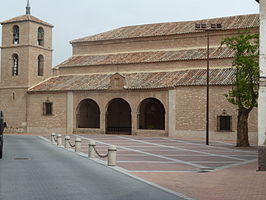Santa Olalla, Toledo

http://ceip-ntrasrapiedad.centros.castillalamancha.es/
Our school is located in Santa Olalla, a town with a population of about 2300 people, between Toledo (the capital city of Castilla-la Mancha) and Talavera de la Reina and also quite near Madrid (80 kms).
“Nuestra Señora de la Piedad” is a public school. There are about 300 pupils from 3 to 12 years old, they are in separated buildings (infant school and primary school). The number of teachers is 26, including an educational counsellor, an audition and language teacher and a therapeutic pedagogy teacher who attends children with special needs. Our timetable goes from 9:00 a.m to 14:00, with a half an hour break.
From 2008 we are working in the programme Bilingual Sections (before called European Sections), from then, we teach some subjects in English (Science and Art). At the 4º grade, pupils also start learning French.
The school is located in a rural environment. The economic activity of the town is based mainly on the commerce and services sector; agriculture and cattle raising, apart from a little industry related with animal feed or marzipan and also some wood or metal workshops.The socio-economical background of the students families is medium or medium-low.
The special needs are very varied ( down´s syndrome, autism, hiperactivity...) and others related with language problems or low capacities. In our school there are not refugees students at the moment. We have some immigrants families from Morocco, Romania., Colombia and China
The general needs of our students are improving their communicative skills. The oldest ones are more interested in beeing well prepared in all the subjects to afford the change to a new level (high school) in a new location (they have to move12 kilometres each day to the next town). Our students are quite heterogeneous, they have different levels of interest and knowledge.There are some students with high marks in all subjects, but most of them have a medium level.
We have taken part in several courses related to CLIL, we have participated in P.A.L.E. programme, in which we had the opportunity of attending several talks about new methodologies in teaching English and also we met English native people from all parts of the world. From 2008, the school is included in the project “Bilingual Sections", working with language assistants from U.S.A and U.K.during three courses. The school also collaborated in a Comenius project in 2004 “ A child, same rights, same duties” with teachers from Belgium and Romania. We keep in contact with some European teachers and this year, pupils in the 4º grade have pen friends in Sweden In previous years we did some skype connections with children in a Polish school. We use CLIL methodology in Science and Arts.
Our school needs are:
-to improve our teachers and pupils communicative skills in English
- to collaborate with other European schools to get information about methodologies and resources that we would like to include in
our own teaching and to motivate our students with new experiences and information about English speaking
countries.
- it is important for us the correct internationalization of our school, open our doors to Europe (for
example, we celebrate Europe Day, every year each 9th May, we have a special Europe corner in one of the
corridors).
- our pupils need to get in touch with European children to know about their daily lifes, their schools, their
activities, their celebrations… so , they will need to use English to communicate each other.
